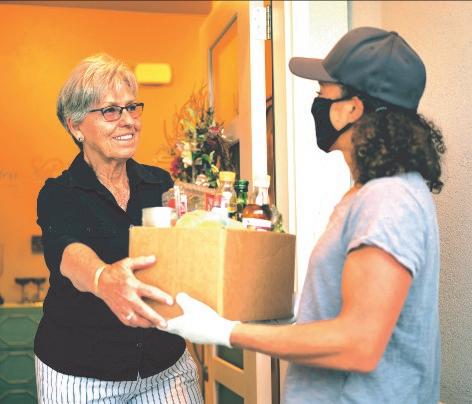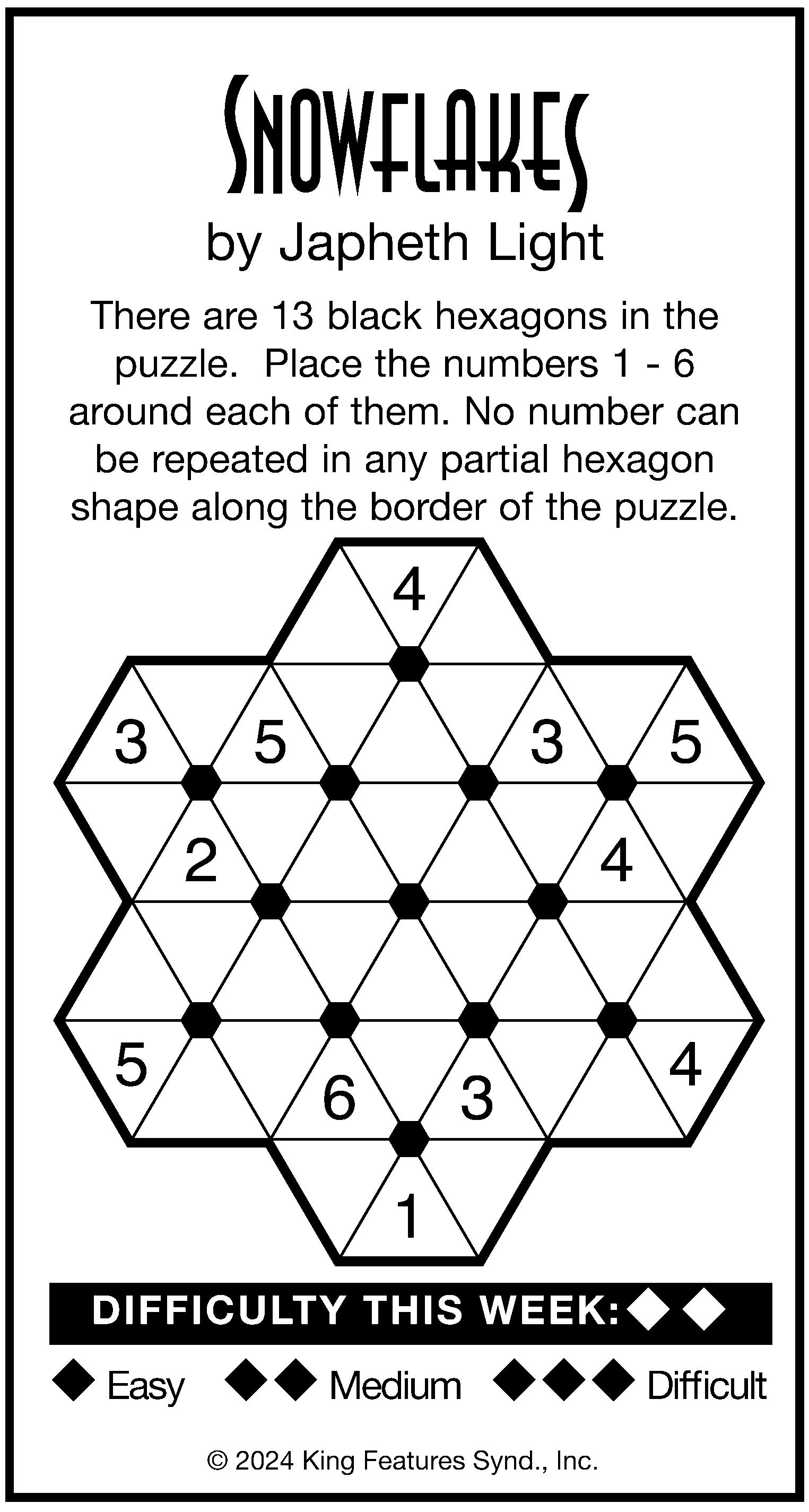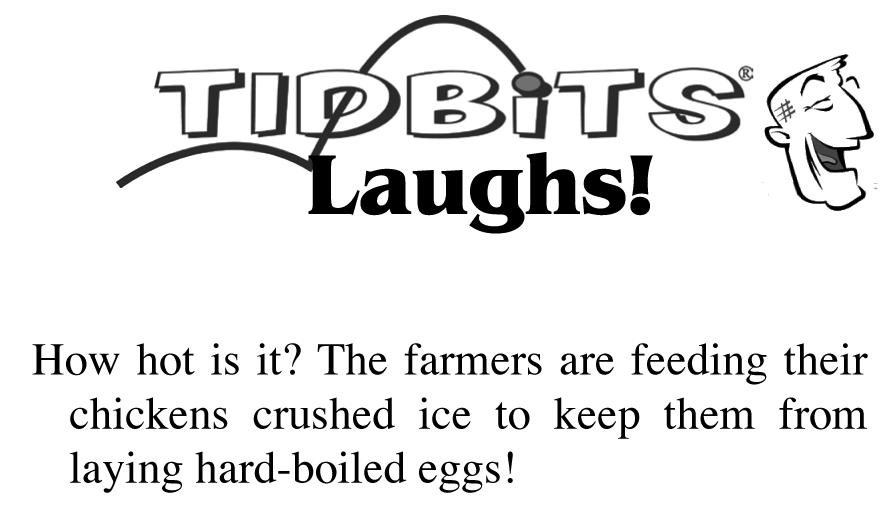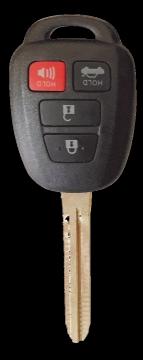










Heat waves are the single deadliest weather phenomena in the U.S., killing more people than hurricanes, wildfire, blizzards, or floods. Come along with Tidbits as we deal with heat waves!
• In 2003, Europe’s worst heat wave in 500 years afflicted the continent with temperatures reaching a high of 115°F (46°C) in places. Throughout August, temperatures averaged 20 to 30% higher than normal. Over 30,000 people died across the continent. The populace was unaccustomed to dealing with such heat and there was little they could do to adapt on such short notice. Most vulnerable were elderly childless women who lived alone.
• Particularly hard hit was France, who suffered an estimated 15,000 casualties. Paris was badly affected. The hospitals and morgues were so overwhelmed that they purchased refrigerated food trucks and rented a refrigerated warehouse to store the bodies until they could be buried.
• About 80% of buildings in Paris have zinc roofs, amounting to over 100,000 buildings. Zinc roofs are extremely picturesque, but they also heat up like a sizzling griddle on hot days. People living on the top floors of buildings with zinc roofs bore the biggest brunt of the heat. (cont)




























In this issue of TidbitsMOV our girl Tammy Tidbits is hiding.

• Another contributing factor in the high death rate in 2003 was that Paris has very few urban trees, with only 9% of the city streets shaded by a tree canopy, compared to 18% in Boston, Massachusetts, and 29% in Oslo, Norway.
• During a Texas heat wave in 2011, drought and heat killed off an estimated 10% of all urban trees statewide.
• In Austin, Texas, “tree inequality” is more pronounced than in most cities, with rich neighborhoods having many large shady trees, and poorer neighborhoods having few.
• When officials in Seoul, South Korea restored a stream that ran through the middle of the city, and planted numerous shade trees, the temperature of the surrounding neighborhoods dropped by ten degrees.
• The city of Curitiba, Brazil, (pop. 3.8 million) is known as “the greenest city on Earth” because they’ve dedicated over 24 square yards (20 sq. m) of green space per citizen, whereas Buenos Aries, Argentina, by contrast, has only two. Many other cities have virtually none.
• It’s estimated that 30 million people in the U.S. live in areas of extreme heat, defined as a mean annual temperature above 85°F. (29° C) Unprotected (un-air conditioned) humans die if the temperature fails to fall below 104° F (40°C) at night for a prolonged time, giving them a chance to recover.
• A camel can go eight to ten days without water during hot seasons, losing up to a third of its weight by dehydration. They’ve also adapted to be able to drink salt water that’s even saltier than sea water, and to eat salty plants other animals ignore.



When you find her, to enter the weekly contest, please send us a message including name, mailing address and email, the issue number you are referring to and which ad is hosting Tammy for the week! Visit www.tidbitsmov.com or send the answer with the above information to alan@tidbitsmov.com OR you may send us a private message to our Facebook page - Tidbits MOV.
PLEASE do not post the answer directly to the page - that ruins the fun for everyone. All winners will be drawn randomly from correct responses and will be posted weekly. As with all our contests, though you are welcome to play every week, you are only eligible for one winner per household per month. www.tidbitsmov.com














• An ant that lives in the Sahara desert has specialized skills to survive the heat. The ant only goes out when it’s too hot out for anteating lizards to be out, which means temperatures of 122°F (50°C) or so They have long legs and run fast over super-heated sand, covering up to a yard per second. This is equal to a human running about 450 mph (724 kph). The ant sports silver-colored hairs on its body, which reflect heat away. The ant can only be exposed to the heat for a few minutes before returning to the cool relief of underground burrows.
• Pacific salmon require cold water in mountain streams, and cool ocean water. They prefer water that is 58°F (14°C) or less. When the water temperature rises above 59°F, they begin to struggle. Diseases become more prevalent and they succumb to predation at higher rates. If the water temperature tops 70°F (21°C), it forms an impenetrable barrier that salmon cannot navigate through. When heat waves in California in 2011 raised the temperature of salmon-filled rivers beyond their ability to survive, wildlife officials caught the fish and taxied them upstream to their spawning grounds in tanker trucks.
• Many arctic birds have black feathers, the better to absorb heat from the sun. However, when temperatures rise, they easily become overheated.
• Bumblebees are disappearing from areas eight times faster than they are colonizing other areas because of the heat.
• Although extra carbon dioxide in the atmosphere is somewhat beneficial to plants, the heat caused by excess carbon dioxide is far more detrimental than beneficial. Leaves are unable to photosynthesize at temperatures of 116°F (47°C) or above. (cont)











• Most plants are about 97% water, compared to humans which are about 60% water. When plants are subjected to inordinate heat, it messes with their metabolism just like it does ours, by raising it and increasing their need for water. The hotter it gets, the more water they need. To keep themselves cool, their leaves “sweat”, giving off water in what’s called “transpiration.” Most plants transpire their weight in water every day during normal temperatures, which would be equal to humans needing to drink 20 gallons (76 l) of water a day. If the temperature rises from 70 to 95°F (25 to 35°C), the plant needs twice the amount of water to survive.
• A one-acre plot of corn in Iowa can sweat 4,000 gallons (15,150 l) a day on a typical summer day, enough to fill a typical backyard swimming pool.
• Heat can promote the growth of a deadly fungus that grows on corn.
• Excess heat destroys the pollen tubes of corn plants, preventing fertilization which thwarts formation of the ear of corn.
• Heat changes the timing of blooms of many species of flowering plants, often making the plant miss the peak season for pollinators.
• A heat wave off the coast of California in 2013 resulted in the wholesale destruction of the entire local population of sea stars, a type of starfish. Sea stars are one of the primary predators of purple sea urchins. With the absence of sea stars, the sea urchin population exploded. Sea urchins eat kelp. Entire kelp forests, once vibrantly full of myriad sea creatures, vanished within weeks.
• The Mediterranean Sea is particularly vulnerable to heat spikes, with the water sometimes rising by 11°F (6°C) above normal, scorching sea life. These events have been likened to underwater wildfires.






Roll out the red (sauce) carpet, because it's that time of the year again National Meatball Day is upon us! This coming Saturday, March 9, 2024, we commemorate the humble meatball.
The meatball stands as a beacon of convenience, flavor and thriftiness in the kitchen. From ancient Chinese recipes to Arabic delights and Roman feasts, meatballs have graced tables across civilizations for millennia, each culture adding its own unique twist.
Whether nestled in a bed of spaghetti or adorning a sub sandwich, let's dive into the delightful world of DIY meatballs. This recipe can utilize any ground meat that happens to be on sale this week, making it budget friendly and flexible. You can vary the seasoning to complement your sauce of choice.
Yield: 4 to 5 servings
Total Time: 22 to 35 minutes
1 pound ground meat (beef, pork, turkey, chicken, sausage or combination)
1/2 cup seasoned breadcrumbs
1/4 cup grated Parmesan cheese
1/4 cup milk
1 large egg
2 cloves garlic, minced 1 teaspoon dried Italian seasoning (or another seasoning blend)
1/2 teaspoon salt
1/4 teaspoon black pepper
Olive oil (for cooking)
Preheat your oven to 375 F (190 C). Line a baking sheet with parchment paper or lightly grease it with olive oil.
In a large mixing bowl, combine the ground meat, breadcrumbs, Parmesan cheese, milk, egg, minced garlic, Italian seasoning, salt and black pepper. Use your hands or a spoon to mix until well combined. Be careful not to overmix, as this can result in tough meatballs. Shape the meat mixture into meatballs about 1 to 1.5 inches in diameter. Place them on the prepared baking sheet, evenly spaced apart. If baking, lightly brush or spray the meatballs with olive oil to help them brown and crisp up in the oven. Alternatively, if frying, heat a large skillet over medium heat and add a tablespoon of olive oil.
If baking, bake the meatballs in the preheated oven for 20-25 minutes, or until cooked through and browned on the outside. If frying, cook the meatballs in batches, turning occasionally, until browned on all sides and cooked through, about 10-12 minutes.
Once cooked, remove the meatballs from the oven or skillet and let them rest for a few minutes before serving.
Serve the meatballs hot with your choice of sauce. They pair well with marinara sauce, barbecue sauce, creamy Alfredo sauce, sweet and sour sauce or any other favorite sauce of yours. Freezing meatballs is a smart way to save time and ensure you always have a delicious meal on hand. Once cooked, cool the meatballs completely, then transfer them to a freezer-safe container or resealable bag and store in the freezer for up to 3 months.
Meatballs are incredibly versatile and can be served in a variety of delicious ways. Here are





1020 Pike St Marietta 740.374.9945 Mon-Sun 9am - 6pm

some ideas beyond spaghetti and subs:
Meatball Sliders: Serve meatballs on mini slider buns with your favorite toppings like cheese, lettuce, tomato and a drizzle of sauce.
Meatball Bowls: Serve meatballs over a bed of cooked grains like rice, quinoa or couscous, and add your favorite veggies and sauce for a customizable and nutritious bowl.
Meatball Soup: Add cooked meatballs to a pot of broth along with vegetables and pasta or rice for a comforting and hearty soup. Top with fresh herbs and grated Parmesan cheese before serving.
As we celebrate this savory occasion, let's embrace the culinary marvel that is the meatball by inviting your friends and family and hosting a meatball party! You'll be everyone's favorite person for at least a week.
***
Lifestyle expert Patti Diamond is the penny-pinching, party-planning, recipe developer and content creator of the website Divas On A Dime Where Frugal, Meets Fabulous! Visit Patti at www.divasonadime.com and join the conversation on Facebook at DivasOnADimeDotCom. Email Patti at divapatti@divasonadime.com (c) 2024 King Features Synd., Inc.
Homemade meatballs in marinara ready to tantalize taste buds and warm hearts.
PHOTO CREDIT: www.JasonCoblentz.com

www.rmcrowley.com















• Humans are born with between 2 million and 4 million sweat glands located all over our bodies except in a few places, like the lips, nails, nipples, eyeballs, and ear canals.
• Sweating is triggered by various things: physical activity, being in a hot place, emotions, fever, hormones, pregnancy, toxins, and food. Sweating because of the heat, sweating due to exercise, and sweating from stress are all slightly chemically different.
• Sweat itself is a clear, odorless liquid made of of water, salt, proteins, and oils. However, there are two different types of sweat glands.
• Eccrine glands, which are located all over the body, produce sweat that cools the skin through evaporation. This type of sweat is 99% water combined with trace amounts of potassium, chloride, and sodium.
• Apocrine glands, dormant until puberty, are located only in the hairier parts of the body: armpit, groin, and scalp. This kind of sweat is thicker (and smellier) because it contains fatty acids and proteins that provide a feast for the bacteria that live on the skin. The bacteria break it down into a by-product called propionic acid, which comes from the same family as ordinary vinegar. However, these microbes are not all bad because they protect the skin from invading germs.
• Some factors can affect the smell of sweat, including humidity, caffeine, nicotine, alcohol, and various medications. Diet also contributes to the odor, particularly things like onions, curry, cumin, garlic, fatty foods, and red meat. Spicy hot foods irritate the nerves leading to the sweat glands, activating them. Sportswear is often made from synthetics such as Lycra or polyester, materials that wick away sweat but tend to retain body odor. (Continued page #7)








































DEAR PAW'S CORNER: I walk my neighbors' dogs every day after school. It takes time because I have to walk one dog at a time, then go to the next house, and then the third one. I'd like to make this job a little more efficient by walking all three dogs at the same time. What's the best way to do this? Colin R., Smyrna, Georgia DEAR COLIN: I can see your dilemma! Walking three dogs separately takes at least one hour, probablytwo, when you add in the time spent accessing each home, leashing up the dogs and unleashing
It is possible to walk all three dogs at once, but you have to do two important things first: One, get permission from each neighbor to walk the dogs together, and two, make sure the dogs will get along before you commit.
You may be able to only walk two of them together and the third one alone. And if the neighbors don't agree, then you're stuck walking all three separately.
If you do get permission to walk them together, do it on a trial basis. Here are a few tips from professional dog walkers: Don't use retractable leashes when walking multiple dogs. You need full control at all times.
Leashes can easily get tangled; hold two in one hand and one in the other, or buya 3 -wayleash coupler to minimize tangles. If one or more dogs gets aggressive or bullying, walk them separately to prevent the problem from getting worse. Avoid walking them in areas where a lot of other dogs are present. If all three bolt toward another dog, you may not be able to hang on to them.
Send your tips, comments or questions to ask@pawscorner.com.
(c) 2024 King Features Synd., Inc.











• For sweat to cool us down, it must evaporate; humidity makes it more difficult. Thus the sayings, “It’s not the heat; it’s the humidity!” and “At least it’s a DRY heat!”
• When water evaporates from the skin, turning from a liquid into a gas, it removes heat from the blood. Cooler blood travels around the body, keeping organs the correct temperature.
• Sweat glands are coiled loops just below the skin’s surface, leading to a duct, which lead to the pores. The sweat is water pulled from the blood and surrounding tissues. The more you sweat, the saltier the sweat; the less you sweat, the less salty. This is because the longer the liquid remains in the coil, the more time the body has to reabsorb the potassium, chloride, and sodium. If you’re sweating up a storm, there isn’t enough time to do that as the sweat moves through the coil quickly. This is why the skin tastes saltier the more you sweat. Sports drinks like Gatorade are formulated to replace the salts lost due to heavy sweating.
• We are born with all the sweat glands that we will ever have. It takes about two years after birth for sweat glands to mature. Babies are less able to regulate their body temperature than adults, and are more susceptible to heat.
• Babies born and raised in warm climates develop more active sweat glands than those born in cool climates. If you move to a hotter climate than you’re accustomed to, your ability to sweat increases in about six weeks.
• People of East Asian descent often have a particular gene that makes their sweat less odiferous than others.
• There are not very many species of animal that sweat. Humans have ten times more sweat glands than chimpanzees, who mainly sweat from their armpits. Athick layer of hair prevents the rapid evaporation than a human’s thin layer of hair promotes.




* Use a muffin pan to make cookie cups for ice cream or fruit. Just flip your muffin pan over, and press dough over the upturned wells. It will puff up a little, but once it settles, they make very nice bowls. I do this with pizza dough as well. Prebake for a few minutes to form the bowl, then fill with ingredients and complete baking.

vice (e.g. TV, Xbox, cable box) on the tag, then clip it to the plug end of the cord. When you need to unplug, it'll be easy to see which is which." C.C. in Ohio
* Travel a lot? Make use of those shower caps by pairing up shoes and using the shower cap to hold them together while simultaneously protecting your clothes from the shoe bottoms. Smart!



* If you can put a tension rod in the cabinet under your sink, you can use it to hang spray bottles for extra storage. It's amazing how much space clears up, and it's easy to find the bottle you need.
* Got popcorn? For a healthier (and much less expensive) version, go old-school: Put popping corn kernels in a regular brown paper bag, seal the bag, then microwave.
* "Bread tags (the little plastic clips that hold bread bags closed) make great cord organizers when you are using a multiple outlet power strip. Write the kind of de-
* "I make plenty of cupcakes for my children's various events, but I kept having unreturned cupcake carriers. Those things are expensive! I make my own now, using a box lid. The lids for paper cartons work really well. Cut a cross into the lid top with a razor or carpet knife, and press down. Make it the size of a cupcake. Insert cupcakes and go." A.R. in Georgia
Send your tips to Now Here's a Tip, 628 Virginia Drive, Orlando, FL 32803. (c) 2024 King Features Synd., Inc.

